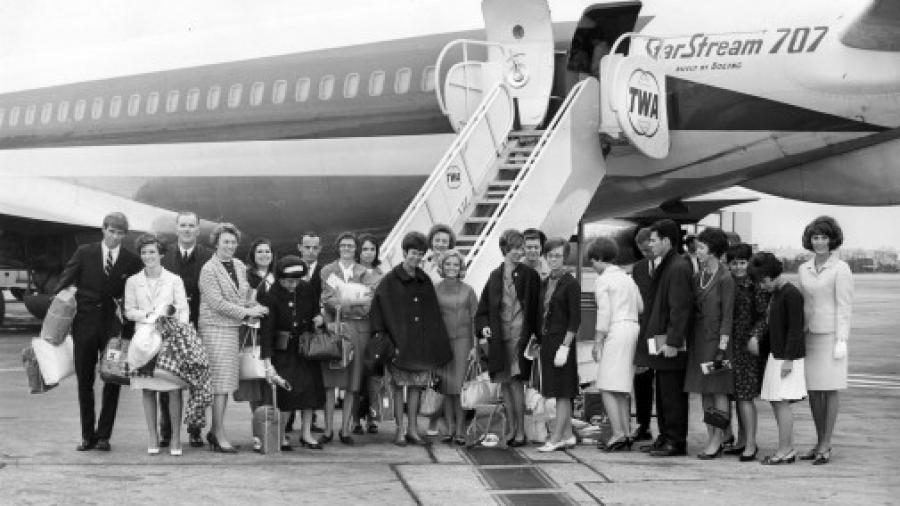Westmont Magazine A Community Called to Global Service

Westmont students travel overseas in the 1960s. Photo courtesy of the Westmont archives.
Many of the students who enrolled at Westmont during its earliest years envisioned careers as missionaries, answering God’s call to take the gospel throughout the world. Ruth Kerr and the other founders set the school up as the Bible Missionary Institute in 1937. But Mrs. Kerr soon recognized that the mission field also required people with professional training: teachers, doctors, lawyers and others who could share both their expertise and their faith. In 1940, the school became Westmont and adopted a four-year liberal arts curriculum.
World War II focused attention on international affairs and shaped the school throughout the 1940s. In response to the conflict, 66 mostly male students, faculty and alumni left to join the service. Evelyn Starr Lesslie, associate professor of English, wrote in the August 1944 Quarterly Bulletin,“More than ever before, we now need intelligent men and women, trained leaders with the high moral purpose and stability derived only from a living faith in Him who changes not…. This is the postwar challenge to Westmont College: to train choice young people in the best that has been known and thought, not as an end in itself, but as a means of sharpening tools for world service.”
Generations of Westmont graduates have embraced this idea of global service. They’ve entered the mission field as Bible translators, doctors and teachers and pursued various professional careers overseas. A surprising number of the Golden Warriors who return to campus to celebrate their 50th class reunion have lived and worked outside the United States, and younger alumni continue this tradition.
In the 1960s, Westmont faculty began developing academic programs off campus. Europe Semester started small in the 1960s with one professor and 10 students, but it soon grew into an important part of the college’s curriculum. Every fall, Westmont professors lead students on a pilgrimage to Europe’s great cities and museums, an adventure that blends intensive study with first-hand experience of the places and people that have shaped European history and cultures. Students read, research and write extensively, travel widely, and learn from experts and everyday people in many countries.
Two sociology professors taught a three-week course in San Francisco in 1968 that quickly evolved into the semester-long Urban Program. From the start, this program focused on professional internships in the city and urban studies classes. Although the college renamed it Westmont in San Francisco in 2010, the semester continues to immerse students in the economic and racial diversity of urban areas. Three full-time professors run the program at the historic Clunie House, a Victorian mansion in the center of the city.
Since 1972, English professors have directed England Semester, which combines travel to literary and cultural centers with residential study in the British Isles. Professor Arthur Lynip and his students returned to campus in 1974 with a wardrobe that C.S. Lewis had owned; they bought it because it matches the description of the wardrobe in “The Lion, the Witch and the Wardrobe.”The English department proudly installed it in Reynolds Hall, where it remains.
When the college established the six-week Mayterm program (which follows the spring semester), professors began leading classes to places such as China, Southeast Asia, Africa, India and Europe. To further expand international programs, the college developed Westmont in Mexico in 2004, which takes students to Querétaro for a semester to live with local families, study with Mexican university professors and travel. The college’s newest off-campus program, Westmont in Istanbul, debuted in spring 2012, and alternates with Westmont in Jerusalem, scheduled for spring 2013.
Student outreach has also grown more international. Through Lei O’Limas, students traveled to rural Hawaii for summer missions in the 1960s. Potter’s Clay, the annual outreach to Ensenada, Mexico, began in 1977 and continues to involve a significant number of students. Now known as Emmaus Road, Westmont’s summer ministry program sent 71 students to Bolivia, China, Guatemala, Nepal, Uganda, Spain, Japan, Israel and Indonesia in 2012.
President Gayle D. Beebe seeks to expand opportunities for students to study and serve overseas and develop a global perspective, thus continuing a 75-year-old Westmont tradition.